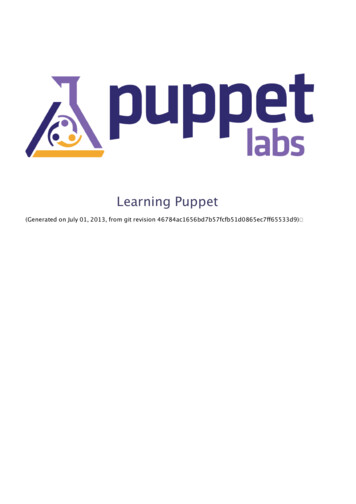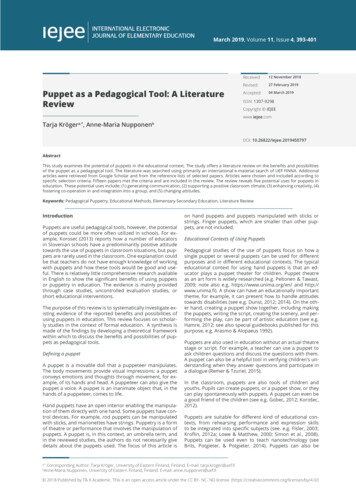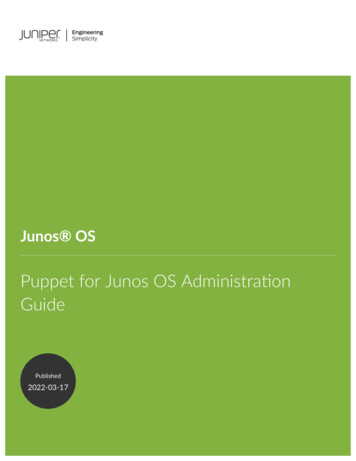
Transcription
puppet#puppet
Table of ContentsAbout1Chapter 1: Getting started with puppet2Remarks2Versions2Puppet Open Source2Examples3What is puppet and why should I care?3Is it for you?6Before you startup6Official Documentation6Installation6System Requirements6Check your network configuration:6Installing Puppet Server7Enable the Puppet package repositories7Chapter 2: Agent9Syntax9Examples9What is it?9Trigger9Verbose output9LoggingChapter 3: Handling NFS es11Mounting a remote NFS driveCredits1112
AboutYou can share this PDF with anyone you feel could benefit from it, downloaded the latest versionfrom: puppetIt is an unofficial and free puppet ebook created for educational purposes. All the content isextracted from Stack Overflow Documentation, which is written by many hardworking individuals atStack Overflow. It is neither affiliated with Stack Overflow nor official puppet.The content is released under Creative Commons BY-SA, and the list of contributors to eachchapter are provided in the credits section at the end of this book. Images may be copyright oftheir respective owners unless otherwise specified. All trademarks and registered trademarks arethe property of their respective company owners.Use the content presented in this book at your own risk; it is not guaranteed to be correct noraccurate, please send your feedback and corrections to info@zzzprojects.comhttps://riptutorial.com/1
Chapter 1: Getting started with puppetRemarksThis section provides an overview of what puppet is, and why a developer might want to use it.It should also mention any large subjects within puppet, and link out to the related topics. Sincethe Documentation for puppet is new, you may need to create initial versions of those relatedtopics.VersionsPuppet Open SourceVersionRelease //riptutorial.com/2
VersionRelease 1-030.9.22005-11-22ExamplesWhat is puppet and why should I care?Puppet is a configuration management solution. Users describe the desired state of a server orsoftware and configuration management achieves this state. This brings following advantages: Configurations can be reproduced exactly the same every time, as many times as necessaryhttps://riptutorial.com/3
Configurations for all software and servers are stored in a central location. This makesbackup and version control of configurations easily achievable Changes to all servers propagate through the entire infrastructure within a couple of minutes,without having to log in to any machine directly Everything is described in the same language, making it easy to configure new software Modules are similar to libraries and allow configurations to be consolidated. Modules for allmajor software packages already exist, making installing them extremely easy Servers can share information between each other, influencing the configuration of otherservers. For example a new server can automatically register itself with the load balancerand monitoring solutionPuppet uses Ruby to describe the desired state of a server, called a node. It does so with the useof primitives called resource types. By default, every 30 minutes, the puppet agent authenticatesitself against the puppet server. It then sends a list of properties of itself called facts. The serverlooks at the facts and the configuration files called manifests and compiles the desired state forthe node. It then sends that configuration back to the node, where the agent applies it.To give an idea of how powerful this can be, here are a couple examples of increasing complexityshowcasing what puppet can do for you.Example: UserThis example creates the user username on node myserver and adds it to the group wheel.node 'myserver' {user { 'username':ensure 'present',groups ['wheel'],}}This file that would be stored on the puppet server is the manifest. The resource type in thisexample is user. Every resource type has optional and required properties. In this example,ensure is required and groups is optional. This specific configuration would only be applied tomyserver. You can apply configurations to all nodes by placing it outside of a node definition.It is possible to take a couple of resource definitions and store them as modules. A module issimilar to a library. These modules can be shared online, and you usually find one for every majorsoftware package. The official way to share modules is through the puppet forge:https://forge.puppet.com/Example: PostgresThis example installs a postgres server on node myserver, and creates a database db, owned byusername, identified by password. It does so using the postgresql module.node 'myserver' {class { 'postgresql::server': }postgresql::server::db { 'db':https://riptutorial.com/4
user 'username',password 'password',}}In this case postgresql is a module. The module itself takes care of identifying the operatingsystem, downloading and installing the program, and then configuring it according to the manifest.This is a basic example but the module allows a great deal of customization.Note that it is not necessary to know SQL or how to actually install a postgres server to do so.Official modules are well maintained and provide a sane and secure base configuration.It is also possible to use facts in manifests. Facts act like variables.Example: Conditions using factsThis example uses the rsyslog module to configure rsyslog on all non-windows machines.if osfamily ! 'windows' {class { 'rsyslog::client': }} osfamily is a fact. These facts are gathered every time the puppet agent runs. Note that becausethis definition is outside of a node definition, it gets applied to all nodes. However, rsyslog::clientwill only be executed on nodes that do not run windows.Since puppet uses ruby, programmatic elements like control flows and variables can be used inmanifests.With the addition of PuppetDB you can share information between multiple nodes. This allowsone node to influence configuration on a different node. Classic examples include load balancersor monitoring solutions.Example: Registering a host with monitoring using exported resourcesThis example creates an exported resource on a node, and then imports that resource on themonitoring server, adding the host to the monitoring. It is using the Icinga2 puppet module.@@icinga2::object::host { ::fqdn:display name ::fqdn,ipv4 address ::ipaddress eth0,}node 'icinga2' {Icinga2::Object::Host { }}@@icinga2::object::host creates a host definition object. This gets created by every node thatexecutes this code. The @@ marks it as an exported resource. Usually, nodes do not shareinformation in puppet. Exported resources allow to do that.https://riptutorial.com/5
Note that all the property values in the host definition are facts. This means they will be differentfor every node which executes it.Finally, the exported resource gets imported by the icinga2 node. The Icinga2 module isresponsible for making sure that the correct configuration files are created and reloaded.Is it for you?If you do deployments, configure your applications on multiple servers and required to login toyour servers and make some changes in infrastructure, applications, pre-requisits etc. then puppetcan definitely help you.Except all this if you handle a big infrastructure and want a centralized management you can alsohave a look.Before you startupBefore you decide to work on puppet there are few things that you need to know.1. puppet work in both client-server architecture (widely used) as well single machine (speciallyfor testing purpose)2. puppet master can only be configured on a linux machine (master machine/node), windowscan be used only as client (managed machine/node)3. if configuring master, you must be aware of using linux machine and basic commands4. puppet provides it's own configuration language that looks like jsonOfficial DocumentationPuppet provide official documention for both open-source and enterprise versions. you can find ithereInstallationSystem RequirementsHowever, the Puppet master service is fairly resource intensive, and should be installed on arobust dedicated server. At a minimum, your Puppet master server should have two processor cores and at least 1GB of RAM. To comfortably serve at least 1,000 nodes, it should have 2-4 processor cores and at least 4GB of RAM.https://riptutorial.com/6
Check your network configuration:In an agent/master deployment, you must prepare your network for Puppet’s traffic. Firewalls: The Puppet master server must allow incoming connections on port 8140, andagent nodes must be able to connect to the master on that port. Name resolution: Every node must have a unique hostname. Forward and reverse DNSmust both be configured correctly.Note: The default Puppet master hostname is puppet. Your agent nodes can be readysooner if this hostname resolves to your Puppet master.The time must be set accurately on the Puppet master server that will be acting as thecertificate authority. You should probably use NTP.Installing Puppet ServerPuppet provides official packages that install Puppet Server 2.4 and all of its prerequisites on thefollowing platforms.Red Hat Enterprise Linux Enterprise Linux 6 Enterprise Linux 7Debian Debian 7 (Wheezy) Debian 8 (Jessie)Ubuntu Ubuntu 12.04 (Precise)Ubuntu 14.04 (Trusty)Ubuntu 15.10 (Wily)Ubuntu 16.04 (Xenial)Enable the Puppet package repositoriesEnterprise Linux 7sudo rpm -Uvh el-7.noarch.rpmFor other versions look herehttps://riptutorial.com/7
Installing puppet masteryum install puppetserverorapt-get install puppetserverPuppet Server is configured to use 2 GB of RAM by default. To change look hereStart the Puppet Server service:systemctl start puppetserverorservice puppetserver startRead Getting started with puppet online: startedwith-puppethttps://riptutorial.com/8
Chapter 2: AgentSyntax1. puppet agent [--certname NAME] [-D --daemonize --no-daemonize] [-d --debug] [--detailedexitcodes] [--digest DIGEST] [--disable [MESSAGE]] [--enable] [--fingerprint] [-h --help] [-l -logdest syslog eventlog FILE console] [--masterport PORT] [--noop] [-o --onetime] [-t --test] [v --verbose] [-V --version] [-w --waitforcert SECONDS]ExamplesWhat is it?The puppet agent is a service that runs on the servers. Once the service is started, The agent willbe triggered on background every 30 min (by default).The agent have 2 main usages: Send server s facts to the puppet master Receive catalog from the puppet master ans apply itTriggerBy default the agent is triggered every 30 minutes. This interval value can be changed from thepuppet.conf file. Linux- /etc/puppet/puppet.conf Windows - %PROGRAMDATA%\PuppetLabs\puppet\etc\puppet.confSet the runinterval to the wanted interval.runinterval xxxThe agent can be triggered manually with the command:puppet agent -tVerbose outputSometimes it is helpful to get more output on puppet agent run.It is very useful for debugging.Run puppet agent with verbose and debug parameters: debug- Enable full debugging.https://riptutorial.com/9
verbose- Turn on verbose reporting.puppet agent -t --verbose --debugLoggingPuppet agnet logs messages. You can view this logs here:Linux - /var/log/puppet/puppet.logWindows - view the Event Event Viewer)Viewer(Control Panel System and Security Administrative ToolsRead Agent online: ps://riptutorial.com/10
Chapter 3: Handling NFS MountIntroductionNFS is the most common way to share disk between computers in linux. It allows user on a clientcomputer to access files over a network much like local storage is accessed. Here we see how toconfigure Puppet to manage mounting and serving NFS drives.ParametersParameterDetailsnameThe path to local directory in which the remote drive should be mounted.deviceRemote server address and directory path on remote server, separated by :atbootWhether this drive should be mounted while booting. Enabling makes drivesavailable sooner, but may cause delayed boot in case of network or mountingproblem.passFsck order is to tell fsck what order to check the file systems, if set to "0" filesystem is ignored. Usually NFS drives need not be checked in clients, so "0" isa suitable option.Remarks Mount target directory should exists on the client. Mount resource type documentation fstab description and option detailsExamplesMounting a remote NFS drivemount { '/path/to/local/folder':ensure 'mounted',atboot false,device e 'nfs',options 'defaults',pass 0,}Read Handling NFS Mount online: -nfs-mounthttps://riptutorial.com/11
CreditsS.NoChaptersContributors1Getting started withpuppetAnkit Katiyar, Community, Matthieu FAURE, Mor Paz, mzhaase,Peter Souter, Quill2AgentOz Bar-Shalom3Handling NFS MountAmir Ali Akbarihttps://riptutorial.com/12
Chapter 1: Getting started with puppet Remarks This section provides an overview of what puppet is, and why a developer might want to use it. It should also mention any large subjects within









